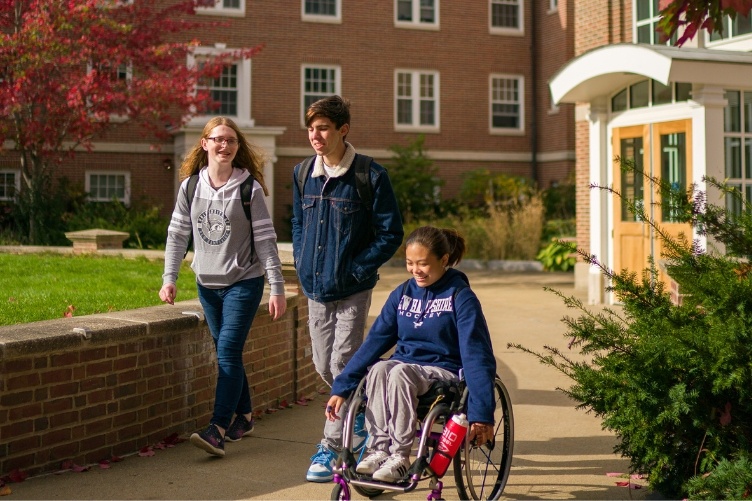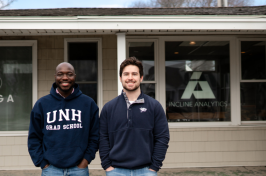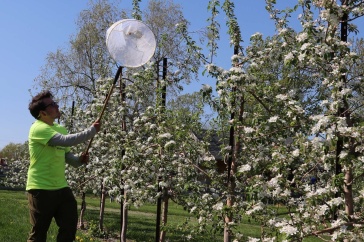
More than one-third of students with disabilities reported experiencing food insecurity within the past 12 months according to a UNH survey.
Key Finding
College students with disabilities encountered significantly higher rates of food insecurity when compared to their counterparts without disabilities. More than one-third of students with disabilities reported experiencing food insecurity within the past 12 months, making them more than twice as likely to face food insecurity than students without disabilities and adversely affecting their academic success and health outcomes.
Key Terms & Facts
College Health and Nutrition Assessment Survey (CHANAS): Expand for definition
An ongoing cross-sectional survey that’s been conducted annually at UNH since 2005, sampling young college adults (18-24). The survey is led by project director Jesse Stabile Morrell and co-conducted by undergraduate and graduate students from COLSA and other UNH colleges.
Disability: Expand for definition
A disability is any condition of the body or mind (impairment) that makes it more difficult for the person with the condition to do certain activities (activity limitation) and interact with the world around them (participation restrictions). Definition by the Centers for Disease Control and Prevention
Food insecure: Expand for definition
A lack of consistent access to enough food for every person in a household to live an active, healthy life. Food insecurity can be either a short-term circumstance or a prolonged condition for families. It serves as an indicator to assess the number of individuals who lack the financial means to afford food. Definition by the U.S. Department of Agriculture
According to the USDA’s Household Food Security in the United States in 2021 report:
- 10.2 percent of U.S. households were food insecure at least some time during the year.
- 3.8 percent of food insecure households had very low food security.
- Households experiencing food insecurity (either low or very low food security) faced challenges throughout the year in ensuring an adequate supply of food for all their members due to limited resources.
- Very low food security represents the more severe end of food insecurity, characterized by instances where one or more members of a household faced reduced food intake and disrupted eating patterns throughout the year due to limited financial means and other resources to obtain food.
New England is one of the least food insecure regions in the United States, with New Hampshire consistently ranking among the most food secure. However, averages can obscure significant variability that can occur among different demographic and socioeconomic groups, such as college students, who experience higher-than-national-average rates of food insecurity. When coupled with other factors that may impair or restrict individuals from accessing food, the adverse impacts of food insecurity are exacerbated. NH Agricultural Experiment Station scientist Jesse Stabile Morrell '99, '04G, '13G and her co-authors are shedding light on the extent of food insecurity among college students with a disability and the detrimental effects on academic and health implications.
Morrell, principal lecturer in the University of New Hampshire’s College of Life Sciences and Agriculture, published the research in Disability and Health Journal with lead investigator Grace Stott ’20, ’21G—a graduate of COLSA’s accelerated Master’s in Nutritional Science program—and Amy Taetzsch ’09, a clinical assistant professor in the department of agriculture, nutrition and food systems. Their findings reveal that college students with disabilities are particularly vulnerable to food insecurity and that over one-third of participants with disabilities experienced food insecurity, with higher rates of low and very low food security compared to students without disabilities.
Higher Rates of Food Insecurity
“Our findings were not surprising, unfortunately, as these populations (college students and persons with disabilities) tend to experience food insecurity at higher rates than the general population when analyzed independently,” said Stott, who works as a research associate at the Gretchen Swanson Center for Nutrition. “For example, data from the [Center of Disease Control and Prevention’s National Health and Nutrition Examination Survey] continually show that adults with disabilities have a greater prevalence of experiencing food insecurity when compared to adults without disabilities."
“Students suffering from food insecurity may have feelings of sadness, anxiety and depression, not to mention worsened sleep patterns and diets. These effects, combined with the increased risk of chronic diseases, highlight the severity of food insecurity's implications, especially on growing adults.” ~ Grace Stott ’20, ’21G
The research used data from 2018–2020 results of the UNH’s College Health and Nutrition Assessment Survey (CHANAS), which, for nearly two decades, has tracked key information on how diet, lifestyle and environmental factors impact the health and wellness of emerging adults (ages 18 to 29) enrolled in college. The work surveyed 880 students of whom 13 percent reported having a disability and 36 percent being food insecure, with a third of those students reporting very low food security.
“Young adults with disabilities face higher rates of unemployment and healthcare costs, leading to higher rates of food insecurity,” said Morrell. “Moreover, college students with disabilities may face additional stressors due to the high cost of education and underutilization of campus services.”
Detrimental Effects on Health and Academics
Importantly, the research also highlights that food insecurity among college students has detrimental academic and health implications. Students experiencing food insecurity may have lower grade point averages, attendance issues and difficulty concentrating, poor mental health and increased risk of chronic diseases.
“Students suffering from food insecurity may have feelings of sadness, anxiety and depression, not to mention worsened sleep patterns and diets,” added Stott. “These effects, combined with the increased risk of chronic diseases, highlight the severity of food insecurity's implications, especially on growing adults.”
UNH's Cats' Cupboard, located in the Memorial Union Building, helps to alleviate food insecurity among UNH students.
The research contributes to existing evidence that limited access to sufficient food among college students is a national issue. A recent report from the Wisconsin Hope Lab showed that 48% of the 43,000 surveyed U.S. college students reported varying levels—from marginal to very low—of food insecurity. And, with 1 out of every 5 college students reporting to have a disability, according to the National Center for Education Statistics, college students with disabilities are often the most likely to have limited resources and accessibility to purchase adequate food, in addition to the typical challenges faced by college students such as navigating financial independence and adjusting to living on their own for the first time.
“Food insecurity is linked to significant negative effects—both health-related and otherwise—so it is especially important to address this major public health concern to ensure students' well-being,” Stott added. “I hope our results inspire institutions to look at their own programs and initiatives and see how they can better support their students with disabilities and those who experience food insecurity.”
In recent years, UNH has implemented several new programs and initiatives—among them Swipe It Forward—aimed at reducing food insecurity. According to Taetzsch, this research and similar studies will help inform campus groups of who may need additional support and how best to target those efforts.
“These findings help to paint a picture of which student subpopulations may be most at risk,” said Taetzsch. “However, there is still a lot to do in the arena of food insecurity, on campus, within the research world, and beyond, and more work is needed, especially in individuals with intellectual and developmental disabilities.”
This material is based on work supported by the NH Agricultural Experiment Station through joint funding from the USDA National Institute of Food and Agriculture (under Hatch award number 1010738) and the state of New Hampshire.
This work is co-authored by Grace Stott, Amy Taetzsch and Jesse Stabile Morrell.
You can read the published article, College Students with Disabilities Report Higher Rates of Food Insecurity, in the Disability and Health Journal.
-
Written By:
Nicholas Gosling '06 | COLSA/NH Agricultural Experiment Station | nicholas.gosling@unh.edu

















































